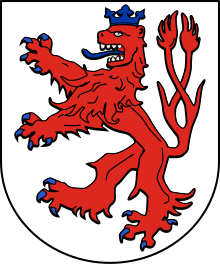Reinforcement (heraldry)
The armor , including weapons , describes body parts such as claws, horns, teeth, beaks, hooves, manes and the like in shape and color in heraldic animals as a common figure . However, the tongue and other soft tissues do not belong to the reinforcement in the strict sense of the word; these are noted separately.
Blazon and tinging
The color of the reinforcement usually differs from that of the coat of arms or the coat of arms figure . One includes the ears of the griffin as well as the comb and wattles of the rooster . The fins can be tinged differently for the fish . All separately colored parts are to be reported in the description of the coat of arms ( blazon ), especially if they have different colors, the reinforcement is also called individually: red tongued, gold armed (everything else in the basic color), or gold reinforced, red tongued ( everything except the tongue gold). The heraldic metals, like gold and silver are preferred to emphasize the defensive character.
If the heraldic animal lacks natural weapons, it is unarmed (unarmed, unarmed) , for example an eagle without claws, a lion without claws, a boar without a tusk. The shape becomes important when the animal parts listed deviate from the basic posture.
Lions and eagles are particularly affected by their frequency in coats of arms, in order to distinguish otherwise identical coats of arms through more specific attributes. Further attributes can be mentioned in one, for example blue armored and crowned.
Linguistically, in German heraldry, the attribute adjectives can be in front or behind, and they can be drawn together with the tinging: a red-armored buck / a red-armored buck / a buck, red-armored and blue-tipped , or they can be replaced by: a buck with red reinforcement and blue tongue : The German heraldry is linguistically not as strict as the Anglo-French.
Special blazon
Special blazon for body parts are (for "color" the reinforcement tinging, which differs from that of the animal):
- Horses with a differently colored mane are mowed "color"
- Horses with a differently colored mouth have "color" muzzle
- Animals with differently colored teeth are "color" toothed
- Animals with differently colored eyes are “color” eyed
- Animals with different colored ears are "colored" eyed
- Birds with a differently colored beak have billed "color"
- Snakes with a differently colored tongue are lined with "color"
If animals (eagle, dolphin) show no / closed eyes and tongue or fish with open mouth, they are languishing . If one counts flames from ears and mouth as reinforcement, then it is flame-spitting, flame-spraying (panther). If the boar's trunk or the tusks are raised, in the case of elephants the tusks, i.e. the guns or throws, then it is emblazoned as thrown or thrown . Without tusks or teeth, these heraldic animals are unarmed . In the case of antlers or the rods or horns, “color” is used to describe rods or “color” horned .
For all expressions, the less ancient form is grumbling, toothed, eyed, ... or toothed, billed , ... possible, or an expression that is closer to natural language.
Individual evidence
- ↑ Christian Samuel Theodor Bernd : The main pieces of coat of arms science. Section 2: General coat of arms science in teaching and application. With the author and E. Weber, Bonn 1849, pp. 200–202 .
